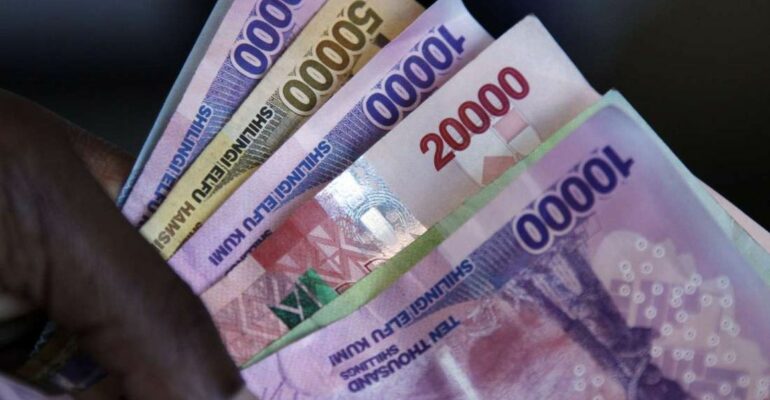Several decades after their independence, Guinea, Ethiopia, Rwanda and 14 other African countries continue to have their banknotes printed in the UK, while others rely on Germany. However, the populations of these countries are largely unaware of the fact that their currency is produced abroad, unlike those of the countries of the CFA zone, who are much better informed on the subject.
17 African countries import their currency from the UK
According to the available data, given a certain lack of communication in this area, both on the part of States and manufacturers, 17 African countries are listed as having their banknotes printed in the United Kingdom, and more precisely in England. In alphabetical order, these are the following countries: Angola, Botswana, Cape Verde, Ethiopia, Gambia, Guinea, Lesotho, Libya, Malawi, Mauritius, Mozambique, Uganda, Rwanda, Sao Tome and Principe, Seychelles, Sierra Leone and Tanzania (which also has its tickets printed in two other countries).
These countries all have in common that they import their currency from the British company De La Rue, which also manufactures most of that of the United Kingdom and which is one of the world leaders in this field. They are mainly divided between former British and Portuguese colonies, to which are added Guinea, Rwanda, Ethiopia and Libya (which also appeals to Russia). As for the production process, it should be noted the recent opening of a site in Nairobi, in 2019, as part of a joint venture with the Kenyan government to ensure part of the manufacture of currencies.
Furthermore, it is worth mentioning the particular case of Somaliland, a territory covering the north-west of Somalia and having proclaimed its independence. Although not recognized by almost all of the international community, it has nevertheless created its own currency to stand out from Somalia, and has it manufactured by the United Kingdom, which once administered the territory (unlike the rest of Somalia). Somalia, which was an Italian colony).
The use of an external entity may come as a surprise for some of these countries, such as Ethiopia and Tanzania, which have a large population, or Guinea and Rwanda, given certain political discourses. But the most surprising case is perhaps that of Libya, in view of its very significant financial capacities, far superior to those of the few African countries which produce their own national currency, such as Morocco, South Africa and the Democratic Republic of Congo (Libya being a major oil producer, of which it has the largest reserves on the continent). In fact, this seems to demonstrate once again the lack of sincerity of the former Gaddafi regime when the latter presented itself as the champion of Pan-Africanism and the independence of the African peoples.
A posture which therefore fell more within the framework of a communication strategy organized by the regime, which had not really tried to develop the country and ensure its sovereignty (hydrocarbons representing around 95% of exports ), and which had even often caused trouble in Africa (attempted invasion of Chad, destabilization of Tunisia, etc.). And this, probably in order to ensure the sympathy and support of African public opinion, in order to obtain the lifting of international sanctions and to guarantee the continuation of an unchallenged reign which had already lasted 41 years at the time of the uprising. of the Libyan people, and making Gaddafi the longest-lived leader of post-colonial Africa. A communication strategy that continues to have a certain effectiveness even today…
At least six African countries import their currency from Germany
In addition to the countries previously mentioned, five others are listed as having their banknotes printed in Germany, to which is added Tanzania which also uses the United Kingdom (as well as the United States). These six countries therefore appealing to Germany are: Eritrea, Mauritania, South Sudan, Eswatini, Tanzania and Zambia. The latter also had part of its currency printed in France.
However, the very partial data transmitted by the German manufacturer of banknotes Giesecke+Devrient (G+D), which does not indicate in detail the central bank clients throughout the world (and to which is added the opacity maintained by many States themselves), suggest that other African countries also call on Germany, at least occasionally, for the manufacture of their national currency (like perhaps Ethiopia, which had in the past publicized the signing of a contract, in 2008).
43 African countries import their currency from abroad
Taking into account the currencies made in countries other than the United Kingdom and Germany, and apart from the specific cases of Somalia and Zimbabwe, which are bankrupt and without real currency, there are therefore 43 African countries in total which have recourse to a foreign country, i.e. 21 countries more than those mentioned above. According to the information available, 20 of these other countries rely on France (which also prints part of the currency of Zambia, already mentioned), while one of them relies on the United States, in Liberia, which had been created from 1821 by the American Colonization Society (and which is added – at least – to Tanzania, of which they partially manufacture the currency).
Thus, and according to the available data, France prints the currency of 21 African countries in total, namely that of 16 of its former colonies (12 countries of the CFA zone, the Comoros, Madagascar, Djibouti and Tunisia), to which s add Guinea-Bissau and Equatorial Guinea (members of the CFA zone, and former Portuguese and Spanish colonies respectively), Burundi (former Belgian colony), and finally Namibia and Zambia, two former British colonies. The manufacturing process is provided by the Banque de France for 17 of these countries, while four others use the private company Oberthur Fiduciaire, one of the three world leaders in the manufacture of banknotes, with the British De La Rue and Germany’s Giesecke & Devrient. But here again, the actual number of countries calling on the services of this French company, at least occasionally, is probably higher.
Nine African countries produce their own national currency
Apart from these 43 countries outsourcing the manufacture of their national currency to a foreign entity, nine African countries therefore assume this process themselves, namely Morocco, Algeria, Egypt, Sudan, Ghana, Nigeria, the Democratic Republic of Congo (DRC), Kenya and South Africa. However, and without this having any connection with the local character of the manufacture of money, it should be remembered, to counter certain propaganda, that five of these nine countries are suffering from a strong dollarization of their economy (the Sudan, Ghana, Nigeria, the DRC and Kenya), that is to say the significant use of the dollar in internal economic transactions, by refusing the local currency, considered risky. The case of Nigeria illustrates the main reason for this situation, with a currency that has lost almost 60% of its value against the dollar since 2014, and more than 99% of its value since its creation in 1973 (when the pound sterling was worth 2 naira, compared to 527 on April 1, 2021).
However, the existence of a certain number of African countries producing their own national currency, and in spite of the serious financial difficulties encountered by some of them (such as Sudan, whose pound has just been devalued by 85% , last February, and which is now one of the five poorest countries in Africa and the most indebted country on the continent), proves that other countries could also take on this task. And this is even truer for those with the advantage of being part of a regional group with a single currency and a sufficiently large population, namely the countries belonging to WAEMU and CEMAC, the two the most integrated groups, by far, of the continent (and which demonstrate, in passing, that pan-Africanism is above all a French-speaking reality).
Explanation: In an article published in December 2020 (https://www.bbc.com/afrique/region-55413027), the BBC gave the floor to Kemi Seba who claimed that it was not normal that the countries of the CFA zone continue to have their currency produced on the very territory of their former colonial power. While this point of view is respectable, it is nevertheless regrettable that the BBC made no mention, either live during the interview or in the text of the article, of the fact that the United Kingdom also produces the currency of many African countries.
Another regrettable element: in this same article, a Senegalese guest affirms (among other inaccurate things) that his country, which would be badly managed because of the CFA franc, is the second most indebted country in ECOWAS, after Cape Verde. However, not only is the truth different, but in addition, you should know that Senegal has not even been part of the four most indebted countries of ECOWAS for a long time… and that there is now even no French-speaking country among the five most indebted countries of this set.

